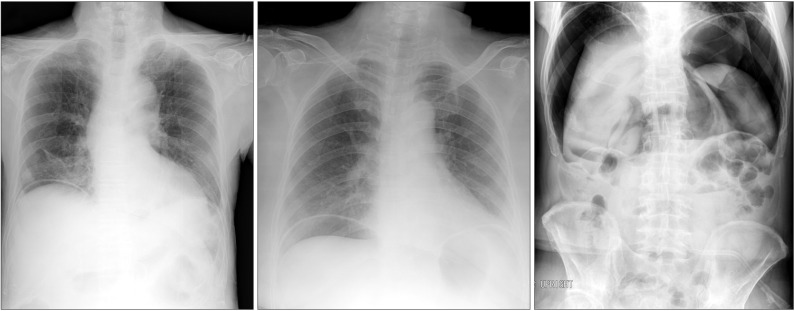Intest Res.
2015 Oct;13(4):313-317. 10.5217/ir.2015.13.4.313.
Reappraisal of Pneumoperitoneum After Percutaneous Endoscopic Gastrostomy
- Affiliations
-
- 1Institute for Digestive Research, Digestive Disease Center, Soonchunhyang University Hospital, Seoul, Korea. iman0825@naver.com
- 2Department of Internal Medicine, Soonchunhyang University College of Medicine, Bucheon, Korea.
- 3Department of Internal medicine, Sungbuk Central Hospital, Seoul, Korea.
- 4Department of Internal Medicine, Eulji General Hospital, Eulji University College of Medicine, Seoul, Korea.
- KMID: 2070746
- DOI: http://doi.org/10.5217/ir.2015.13.4.313
Abstract
- BACKGROUND/AIMS
Pneumoperitoneum is recognized as a benign and self-limiting finding after the insertion of a percutaneous endoscopic gastrostomy (PEG) tube, while complicated pneumoperitoneum is rarely reported. The aim of this study was to reappraise pneumoperitoneum following PEG.
METHODS
We retrospectively reviewed 193 patients who underwent PEG from May 2008 to May 2014. All patients had a follow-up upright chest or simple abdominal radiograph after PEG. Pneumoperitoneum was quantified by measuring the height of the air column under the diaphragm and graded as small (<2 cm), moderate (2-4 cm), or large (>4 cm). Clinically significant signs were defined as fever, abdominal tenderness or leukocytosis occurring after PEG insertion.
RESULTS
Of the 193 study patients, 9 (4.6%) had a pneumoperitoneum visualized by radiographic imaging, graded as small in 5 patients, moderate in 2 patients and large in 2 patients. Clinically significant signs were observed in 5 (55.5%) patients with fever reported in 4 patients, abdominal tenderness in 4 patients and leukocytosis in 4 patients. The time to resolution of free air was 2-18 days. Two patients (22.2%) with moderate or large pneumoperitoneum after PEG died from either pneumonia or septic shock.
CONCLUSIONS
The clinical course of pneumoperitoneum after PEG is not always benign and self-limiting. These findings suggest that clinicians should not neglect a moderate or large pneumoperitoneum, particularly in patients who have an altered mental status or received antibiotics, since peritoneal irritation cannot be observed under these circumstances.
MeSH Terms
Figure
Cited by 2 articles
-
Pneumoperitoneum After Percutaneous Endoscopic Gastrostomy: Does It Have Clinical Significance?
Ju Yup Lee, Kyung Sik Park
Intest Res. 2015;13(4):295-296. doi: 10.5217/ir.2015.13.4.295.Thirty-day mortality after percutaneous gastrostomy by endoscopic versus radiologic placement: a systematic review and meta-analysis
Joo Hyun Lim, Seung Ho Choi, Changhyun Lee, Ji Yeon Seo, Hae Yeon Kang, Jong In Yang, Su Jin Chung, Joo Sung Kim
Intest Res. 2016;14(4):333-342. doi: 10.5217/ir.2016.14.4.333.
Reference
-
1. Gauderer MW, Ponsky JL, Izant RJ Jr. Gastrostomy without laparotomy: a percutaneous endoscopic technique. J Pediatr Surg. 1980; 15:872–875. PMID: 6780678.
Article2. Blum CA, Selander C, Ruddy JM, Leon S. The incidence and clinical significance of pneumoperitoneum after percutaneous endoscopic gastrostomy: a review of 722 cases. Am Surg. 2009; 75:39–43. PMID: 19213395.
Article3. Seo YJ, Cha JM, Lee JI, et al. The improvement of nutritional support with percutaneous endoscopic gastrostomy. Intest Res. 2013; 11:120–126.4. Gottfried EB, Plumser AB, Clair MR. Pneumoperitoneum following percutaneous endoscopic gastrostomy. A prospective study. Gastrointest Endosc. 1986; 32:397–399. PMID: 3803838.5. McClave SA, Chang WK. Complications of enteral access. Gastrointest Endosc. 2003; 58:739–751. PMID: 14595312.
Article6. Stassen WN, McCullough AJ, Marshall JB, Eckhauser ML. Percutaneous endoscopic gastrostomy: another cause of "benign" pneumoperitoneum. Gastrointest Endosc. 1984; 30:296–298. PMID: 6489713.
Article7. Wills JS, Oglesby JT. Percutaneous gastrostomy. Radiology. 1983; 149:449–453. PMID: 6414043.
Article8. Wojtowycz MM, Arata JA Jr, Micklos TJ, Miller FJ Jr. CT findings after uncomplicated percutaneous gastrostomy. AJR Am J Roentgenol. 1988; 151:307–309. PMID: 3134805.
Article9. Alley JB, Corneille MG, Stewart RM, Dent DL. Pneumoperitoneum after percutaneous endoscopic gastrostomy in patients in the intensive care unit. Am Surg. 2007; 73:765–767. discussion 768PMID: 17879681.
Article10. Hillman KM. Pneumoperitoneum - a review. Crit Care Med. 1982; 10:476–481. PMID: 7044684.11. Wiesen AJ, Sideridis K, Fernandes A, et al. True incidence and clinical significance of pneumoperitoneum after PEG placement: a prospective study. Gastrointest Endosc. 2006; 64:886–889. PMID: 17140892.
Article12. Dulabon GR, Abrams JE, Rutherford EJ. The incidence and significance of free air after percutaneous endoscopic gastrostomy. Am Surg. 2002; 68:590–593. PMID: 12079145.
Article13. Milanchi S, Allins A. Early pneumoperitoneum after percutaneous endoscopic gastrostomy in intensive care patients: sign of possible bowel injury. Am J Crit Care. 2007; 16:132–136. PMID: 17322012.
Article14. Strodel WE, Lemmer J, Eckhauser F, Botham M, Dent T. Early experience with endoscopic percutaneous gastrostomy. Arch Surg. 1983; 118:449–453. PMID: 6338865.
Article15. Stapakis JC, Thickman D. Diagnosis of pneumoperitoneum: abdominal CT vs. upright chest film. J Comput Assist Tomogr. 1992; 16:713–716. PMID: 1522261.16. Schrag SP, Sharma R, Jaik NP, et al. Complications related to percutaneous endoscopic gastrostomy (PEG) tubes. A comprehensive clinical review. J Gastrointestin Liver Dis. 2007; 16:407–418. PMID: 18193123.
- Full Text Links
- Actions
-
Cited
- CITED
-
- Close
- Share
- Similar articles
-
- Pneumoperitoneum After Percutaneous Endoscopic Gastrostomy: Does It Have Clinical Significance?
- Long Term Efficacy of Percutaneous Endoscopic Gastrostomy
- Massive Gastric Bleeding Occuring after the Replacement of Percutaneous Endoscopic Gastrostomy Tube
- Percutaneous Endoscopic Gastrostomy Through the Sinus Tract of a Surgical Gastrostomy
- A Case of Buried Bumper Syndrome; A case report


